3 The Brightest Light: Waves from the Sun
The word "radiation" has highly negative connotations to non-scientists, but actually everything emits electromagnetic radiation. Electromagnetic radiation is light, either visible or invisible, and most is quite harmless. Sunlight is in the visible, ultraviolet and infrared bands of radiation, while things on Earth emit infrared radiation.
The amount of radiation a substance emits is mostly dependent on its temperature, and partially on the substance. Thermal night vision imaging and infrared photography both take advantage of this principle, as do contactless thermometers.
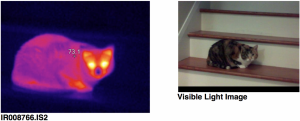
In the infrared image above, you can see that Neko's eyes and ears are warmer, because there's more blood flow through those, and it's closer to her internal body temperature. Her cute little nose is cooler because it's always a little bit wet.
Music break
Stressed or depressed after reading chapter 1 and trying out scenarios of your own? Allow me a minute to tell you about my cat and play some music. Neko is Japanese for cat, but we didn't know that when naming her. Yes, we named our cat "Cat" by accident.
She is instead named after the songwriter Neko Case, who has a voice so rich and powerful that I can only describe with climatic analogies. Her work with the power pop supergroup The New Pornographers (whose music is entirely safe for work, despite their name) can send you soaring through the swiftest winds of the stratospheric polar night jet. Check out songs like "The Bleeding Heart Show" or "Letter from an Occupant" to experience the full 100 m/s glory. Her genre-defining alt-country work, characterized by songs like "Things that Scare Me" and "Outro with Bees" feel like the smoky planetary boundary layer over a smoldering firescape, finally extinguishing after days of raging through a piñon forest. Check it out for yourself in the playlist below, including more than one atmospherically-themed tune.
The Long and Short of Waves
Intensity of radiation is typically measured as the amount of energy that comes through a certain area over a certain time. Intensity has units of watts per meter squared, where a watt is the standard unit of power, equivalent to 1 joule per second.
Electromagnetic radiation is also characterized by its wavelength. For visible light this is its color. Longer wavelength light has lower energy, while shorter wavelengths have more energy. Violet light has shorter wavelength and more energy than red light. Hotter things emit more energetic radiation, i.e., shorter wavelengths. This is why objects glow red, and eventually white as they're heated to extremely hot temperatures.
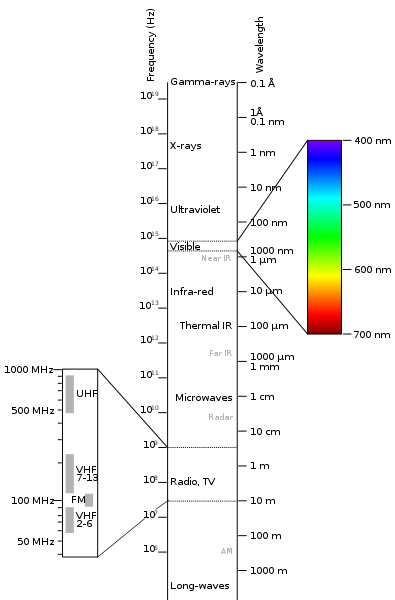
Much of the electromagnetic spectrum is invisible to our eyes. Gamma rays, X-rays, and ultraviolet are the invisible types of light on the high-energy end, while radio wave, microwaves, and infrared are invisible on the low-energy end.
Black-body radiation
Black-body radiation is a theoretical body that absorbs all wavelengths of light. A black body emits radiation only depending on its temperature, with a higher temperature leading to more radiation, and more energetic radiation.
The intensity of radiation is given by the Stefan-Boltzmann equation
[latex]I = \sigma T^4[/latex],
with I = intensity, [latex]\sigma[/latex] = 5.67e-8 W/m2/K4 = Stefan-Boltzmann constant, and T = temperature in kelvin. To get kelvin temperature from Celsius, just add 273.15. This law tells us that the emission of radiation from a blackbody increases rapidly with temperature.
One can calculate the full spectrum of emission of a black body using an equation called Planck's law.
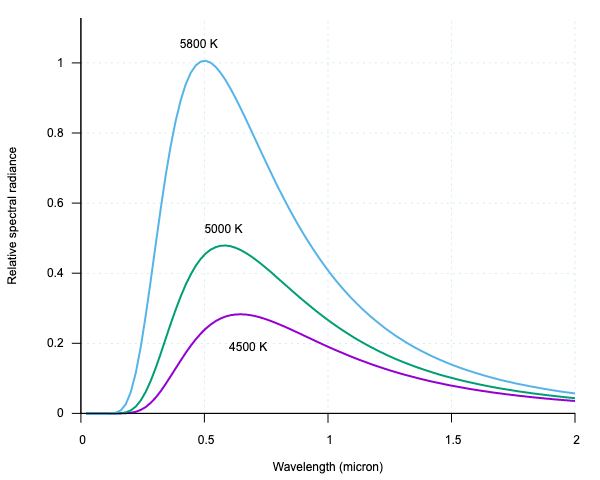
The Sun's spectrum is closely approximated by a black body of temperature 5800 K. In the above plot, you can see that much of the energy is in the 400-700 nm visible range, but there is also ultraviolet and infrared emission.
By the time sunlight reaches the Earth's atmosphere, its intensity is approximately 1360 W/m2. Since the cross-sectional area [latex]A_c[/latex] of Earth is
[latex]A_c = \pi (6371 km)^2 = 1.275e14 m^2[/latex],
the total amount of sunlight incident on Earth is 1.73e17 W (173 PW).
The entire surface area [latex]A[/latex] of Earth is a factor of four larger
[latex]A = 4 \pi (6371 km)^2 = 5.1e14 m^2[/latex],
the average incident solar radiation is 340 W/m2. This number is smaller because half the planet is always experiencing nighttime, and much of the planet receives indirect radiation, with the Sun lower in the sky.
That 340 W/m2 is quite close to the total energy into the climate system, because the Sun is the ultimate source of nearly all the Earth's power. Other lesser (but still tremendous) sources of power include geothermal, which comes from heat diffusing upward from the core of the Earth, created from the initial formation of the planet and from the radioactive decay of certain elements, and tidal power, created from gravitational pull of the Moon and Sun. The steady rotation of the Earth gives two high tides per day in most locations on Earth, roughly when the Moon is closest and farthest from the water.
At terrestrial temperatures, blackbody radiation is much less intense, and at almost completely different wavelengths than sunlight.
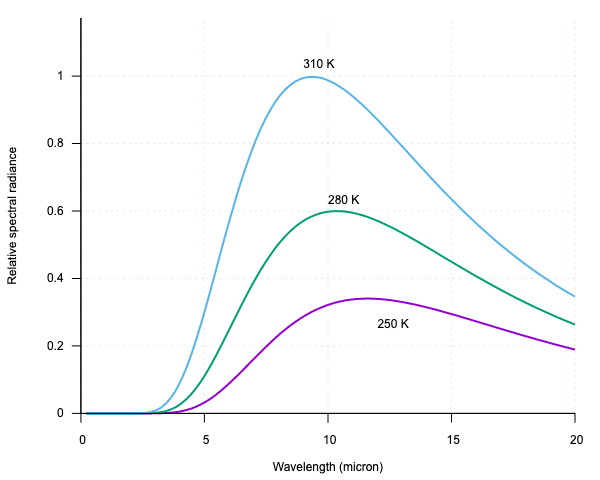
Note that most sunlight is between 0 and 2 microns, while most black body emission at Earth temperatures is at wavelengths longer than 5 microns. The Sun emits infrared radiation, but at quite different wavelengths as the Earth. To clarify the difference between solar and Earth radiation, we call solar radiation (including its ultraviolet, visible and infrared components) "shortwave radiation" and Earth radiation (infrared emitted from the surface or within the atmosphere) as "longwave radiation." There is no overlap between shortwave and longwave radiation.
Spot the Difference
Sunlight is not constant with time; there's an 11-year cycle of higher and lower intensity that goes along with the sunspot cycle. Although sunspots themselves are cooler areas of the photosphere, the surrounding areas overcompensate with increased emission, so times with more sunspots have more sunlight. The amplitude of the cycle is relatively small though, only about 0.07% change from highest to lowest.
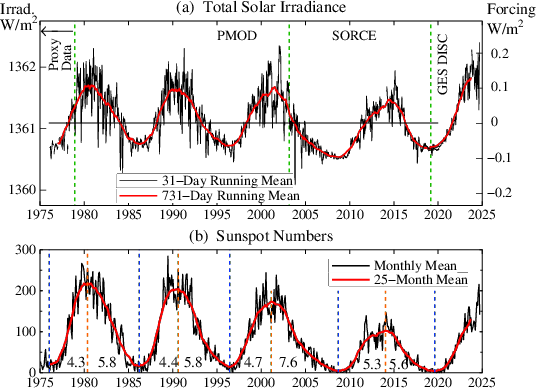
Sunlight incident onto Earth also changes as the Earth-Sun distance varies. If the Earth's orbit around the Sun were a perfect circle, then the radiation onto the planet would always be the same. But the Earth's orbit is very slightly elliptical, meaning at certain times of the year the Earth is closer to the Sun, and sunlight is more intense. The date of perihelion, when Earth is closest to the Sun and shortwave radiation is maximum, is in early January. This makes Southern Hemisphere summers have a bit more sunlight than Northern Hemisphere summers. The date with the most incoming solar radiation receives about 6.5% more shortwave radiation than the date with least. We'll see later that the eccentricity of Earth's orbit and the date of perihelion each varies with time over multi-thousand year timescales, influencing global climate.
This concludes our summary of the properties of sunlight, which from now on we'll call shortwave radiation. In the next chapter, we'll examine what happens when shortwave radiation enters the Earth's atmosphere.
Electromagnetic radiation is light, either visible or invisible. Sunlight is in the visible, ultraviolet and infrared bands of radiation, while Earth's radiation is infrared.

